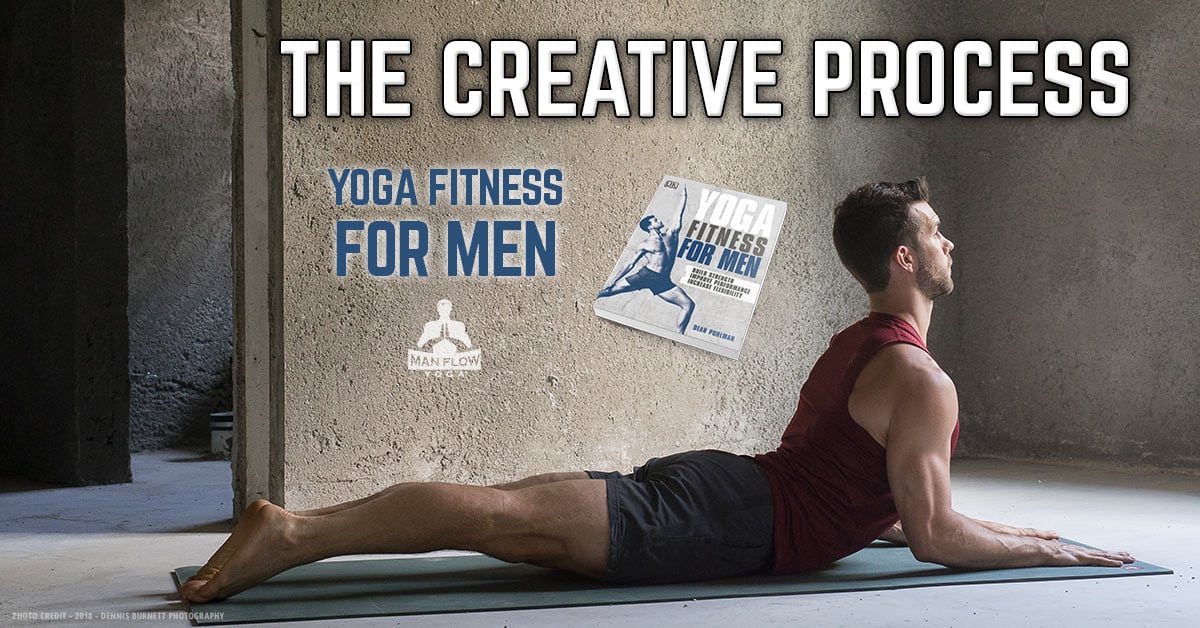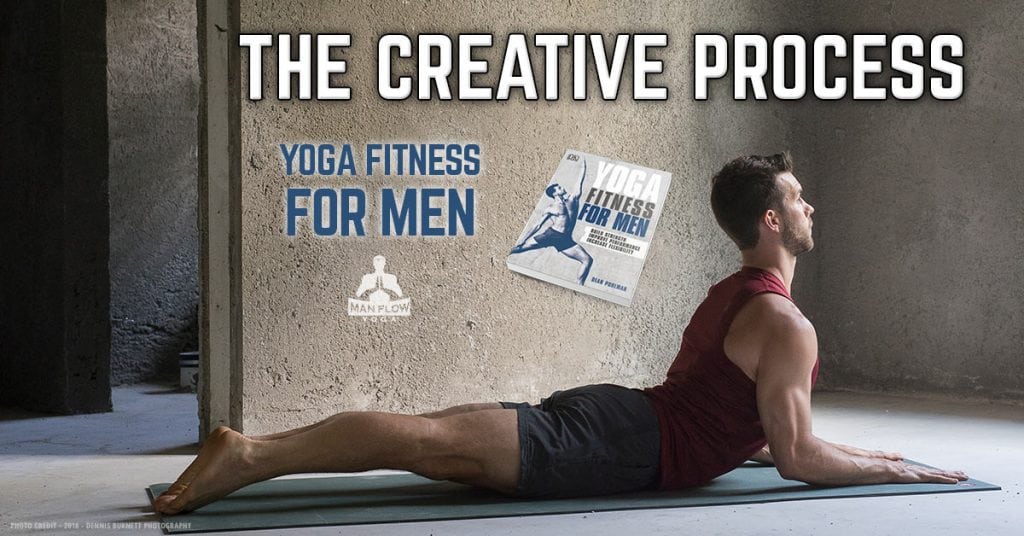
I’m writing this blog to talk about the creative process behind my soon-to-be-released paperback book, Yoga Fitness for Men, published by DK Publishers.
The process I utilized to write the book wasn’t as straightforward as you might assume, and I think it might surprise you! I invite you to read on to learn more about how we created Yoga Fitness for Men.
The book is now available on Amazon and Barnes & Noble, and goes on sale Tuesday, May 8. Purchase it now and send your order confirmation to [email protected], and I’ll give you streaming AND download access to 6 video routines from the book.
Order Yoga Fitness For Men Now!
One other note – Much of the content in this book is actually directly copied and pasted from the Google document discussions I had with the editors at DK. To help highlight the difference between this blog and the notes regarding the creative process of the book (which were written back in July 2017), you’ll find the blog itself in basic black font, and the notes from the creative process in blue italicized font.
And now… the creative process of Yoga Fitness for Men!
You’re probably thinking that the first thing we did was create an outline for the book, and include all of the content we’d put in it. Wrong.
The first thing that happened was me taking charge of the creative process. The book would be unapologetically focused on the physical fitness side of yoga. There were plenty of books on yoga and spirituality. This would make no mention. This was yoga for fitness, pure and simple. (It’s also worth noting that at this point we did not yet have a title for the book, so it was simply referred to as “The Yoga for Men” book.)
I also made it clear that this book had to be something that had never been done before, and would be a tool that readers would be able to use on a continuous basis for years – maybe even decades.
In order to do this, I posited two critical questions. The following questions are copied verbatim from the Google document I used to discuss the book plan with my editors at DK:
- How can we make this book an invaluable tool to readers?
- What can we do to make this book a resource to which people continually return, recommend to their friends and family, and are continually surprised by the value they receive from something as inexpensive as a single yoga class?
Instead of writing up an outline, deciding which poses to include, and what to write for each pose, I started by asking myself to explicitly define the purpose and the goals of the book.
These 2 straightforward, but thought-provoking questions told me that this book needed be more than just a yoga man-ual. It also had to inspire men to do yoga in the first place.
In answering these 2 questions, I decided the book should do the following 3 things:
- Be a fitness resource to be used as often as possible. More than just information on yoga for men, we want to provide the reader with as much utility as possible; something that they can continually refer to for a variety of situations.
- Get people excited about doing yoga. This should get people excited enough to try out routines from the book on a regular basis.
- Give people a plan to get started.
Ultimately, the book had to have 3 parts: (1) the raw information, (2) the inspiration to get you started, and (3) a plan to get you going.
The reason for this is because I knew that not every guy picking up the book would be instantly sold on yoga. Sure, there would definitely be people from the Man Flow Yoga Community that would purchase. Yoga Fitness for Men would also be picked up by guys who already do and enjoy yoga, and wanted to buy a book that reflected their interest. Still more copies would be purchased by guys interested in the benefits of yoga, but turned off by the traditional approach.
But we needed to also to appeal to the guy who was still in the “just interested” phase. He might be browsing the fitness section of a bookstore (or, more likely, browsing the fitness section of a website), come across the title and cover of Yoga Fitness for Men, be intrigued and want to learn more, but at that point wouldn’t be committed to doing yoga at least 3x per week.
Hopefully he had heard enough yoga to understand that it had the potential to help him, and the appearance of the book would make him say, “Hm… this looks interesting. I’ll try it.”
However, purchasing the book would only be the first step.
I was fully aware that a huge number of the people who bought the book wouldn’t even open it. But for those men who did open the book, we needed them to be motivated by what they saw in those first few pages, and get to the point where they actually wanted to do something about it.
To further reduce “friction”, or resistance to starting yoga, we had to make it easy for the guy to get started. For that, we needed to give them a plan to follow. The more explicit the plan, the less you have to think about something, and that gives you more energy to focus on the task itself. (I talked about this in my Be The Better You Program from earlier this year!)
That’s why it was so important that the book be more than just information, but also inspired men to do yoga, and gave them a plan to make it easy to get started.
Now that I knew what the objectives were, I had to figure out how to fulfill them.
And this led to my next set of bullet points:
- The intro should get people excited about yoga. We want to psych men up about the benefits of yoga, about what they can get out of this book if they use it properly.
- The pose guide should be more than just an explanation of the postures. We should explain what they help with specifically, and explain them in the context of what somebody would search for them. People aren’t going to go looking for chair pose. They’re going to look for “how to build stronger hips”, or “how to help with knee pain”
- Pain relief / muscle tightness relief, stiffness relief
- Core / specific muscle strengthening
- Balance improvement
- Good for office workers
- Posture improving
- Imbalance correcting
- Knee / ankle / shoulder (joint) injury prevention / strengthening
- Routines – what do people most ask me about on social media and email? What are the questions that people ask me over and over when it comes to yoga? What solutions can be provide in the format on a routine/workout?
- Ankle mobility
- Knee pain
- Lower-back pain
- Computer neck
- Shoulder clicking and grinding
- How to build muscle with yoga
Based on the relatively small amount of blue italicized font on this page, it doesn’t look like much, but it actually took a couple of weeks to write all of that down. The questions were straight-forward, but the answers took a lot of dedicated, critical thinking to reach.
Once we finished answering those questions, however, I was certain that we had the foundation for an incredible book on our hands, one that people (mostly men, but women, too!) would be able to use for years to come.
Yoga Fitness for Men is now available on Amazon and in-store at Barnes & Nobles and Books-A-Million all over the US.
Click here to purchase your copy!
Get access to 3+ hours of video routines from the book when you order! Just send your email confirmation to [email protected].
Check out this other content from Yoga Fitness for Men !
- The Best Workout You’re Not Doing
- The Keys to Yoga Success (Chapter Sneak Peek!)

Bought your book, where do I send the receipt to get the free downloads. Always appreciate what you do. Thanks Dean. Rich
Hi Richard – you send it to [email protected]. Make sure I can see the product itself in the email confirmation! I can’t look up amazon order numbers.